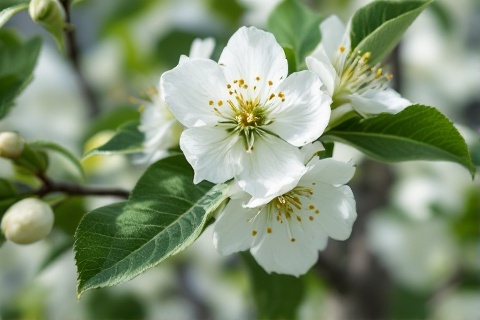
White Tree of Gondor: The Living Legacy
The Symbolic Sapling of Hope and Rebirth
Origins in Valinor

The lineage of the White Tree of Gondor traces back to the very
beginning of the First Age, to mighty Telperion, the Elder of
the Two Trees of Valinor that lit the world before the Sun and
Moon. Telperion's silver light illuminated the Blessed Realm, and its sacred
essence would live on through its descendants long after its destruction by
Morgoth and Ungoliant.
In the city of Tirion upon Túna, the Vala Yavanna created
Galathilion, a perfect image of Telperion, as a gift for the Noldorin
Elves. Though it did not give off light as Telperion did,
Galathilion possessed the same silver-white beauty and sacred nature of its
forebear, standing as a reminder of the light of the Two Trees.
From Galathilion came several notable descendants that would preserve its
lineage. First was Celeborn, which grew in Tol Eressëa where the Elves dwelt.
From Celeborn came Nimloth, the White Tree that would become legendary in
Númenor. This succession of sacred trees maintained a living
connection to the light of the Elder Days, each carrying a spark of Telperion's
ancient glory.
The White Tree of Númenor
The White Tree Nimloth came to Númenor as a profound gift from the Elves of Tol
Eressëa, symbolizing the special relationship between the Eldar and the
Edain. This magnificent tree represented the blessing of the
Valar upon the realm of Númenor and its people, who were granted
a land of their own in sight of the Blessed Realm.
In the city of Armenelos, Nimloth stood in the King's Court, where its beauty
and significance were central to Númenórean culture and governance. The tree's
presence in the royal courtyard served as a constant reminder of the special
status of the Númenóreans and their responsibility as
guardians of this divine legacy.
The tragic destruction of Nimloth came at the height of Númenor's moral decay,
when Sauron, through his cunning counsel, convinced King
Ar-Pharazôn to cut it down. The burning of Nimloth in the year 3262 of the
Second Age marked the final spiritual corruption of Númenor,
leading to the realm's ultimate destruction in the Great
Drowning that followed.
Physical Characteristics

The White Tree possesses a distinctive silver-white bark that captures and
reflects sunlight in a mesmerizing display. This remarkable feature makes the
tree appear to glow from within, particularly during the height of day when
sunlight strikes its surface. The bark's unique coloration serves as a reminder
of its descent from Telperion, the Silver Tree of Valinor.
Among its most enchanting features are the white blossoms that emerge like stars
against its silvery branches. These flowers possess a subtle luminescence that
becomes visible in twilight, creating an ethereal effect that recalls the
ancient light of Telperion. The blossoms seem to capture and hold moonlight,
giving off a soft radiance that enhances the tree's sacred appearance.
The leaves of the White Tree display a striking contrast between their surfaces,
with deep green upper sides that speak to its vitality and silver undersides
that flash in the breeze. This duality creates a shimmering effect when the wind
moves through its branches, making the tree appear alive with inner light.
The flowering cycle of the White Tree follows a pattern that spans most of the
growing season. The blossoms first appear in the early days of summer, dotting
the branches with their star-like appearance. Unlike many other trees, these
flowers persist through the warm months, remaining on the tree until winter's
approach, providing a long-lasting display of their celestial beauty.
Symbolism and Significance
The White Tree serves as a living testament to the direct connection between the
realm of Gondor and the divine powers of Arda. Through its lineage from
Telperion, it represents an unbroken link to the Valar themselves, particularly
to Yavanna the Giver of Fruits. This connection emphasizes Gondor's role as a
preserve of ancient wisdom and divine blessing in
Middle-earth.
Within the context of Gondor's monarchy, the White Tree stands as the foremost
symbol of royal legitimacy and divine right to rule. The health and prosperity
of the tree have traditionally been viewed as a reflection of the king's
worthiness to govern, with the tree's welfare intrinsically linked to the
spiritual authority of Gondor's rulers.
Throughout the history of Gondor, the condition of the White Tree has served as
a living barometer of the kingdom's fortunes. In times of prosperity and wise
governance, the tree flourished with abundant blooms and vigorous growth. During
periods of decline or threat, the tree would show signs of withering, making it
a visible prophecy of the realm's condition.
The First Tree of Gondor

The salvation of the White Tree's lineage came through the courage of Isildur,
who undertook a perilous mission to rescue a fruit from Nimloth before its
destruction. Despite being wounded in this endeavor, Isildur succeeded in
preserving the legacy of the White Tree, ensuring its survival beyond Númenor's
downfall. This act of preservation would prove crucial for the future of
Middle-earth.
Following the establishment of the realms in exile, Isildur planted the seedling
of Nimloth in Minas Ithil, where it grew as a symbol of
hope and continuity. The tree flourished there until the city's tragic fall to
the Nazgûl, marking another dark chapter in the history of the White Tree's
lineage.
The tradition of maintaining a White Tree in the courts of Gondor became a
fundamental aspect of the realm's identity and governance. This practice
connected the kings of Gondor to their Númenórean heritage and, through it, to
the ancient days of glory in Valinor. Each successive tree served as a living
link to this noble past.
The Dead Tree's Vigil
The death of the last White Tree in 2852 of the Third Age
marked a significant moment in Gondor's history. This occurrence coincided with
a period of declining power and influence for the realm, as the line of kings
had been broken and the Stewards now ruled in their stead. The tree's passing
seemed to confirm the waning of Gondor's ancient glory.
For nearly 150 years, the dead White Tree remained standing in the Court of the
Fountain, as custom dictated it could not be removed until a new sapling was
found to replace it. The withered tree stood as a poignant reminder of Gondor's
diminished state and the absence of its rightful king. This period of waiting
became symbolic of the realm's hope for eventual restoration.
The presence of the dead tree in Minas Tirith served as a visible symbol of
Gondor's fading glory and its long wait for renewal. Citizens and visitors alike
would look upon the lifeless branches as a reminder of what was lost and what
might yet be regained if the true heir to the throne should return.
Discovery of the Sapling

The discovery of a new White Tree sapling by Gandalf
marked a pivotal moment in the restoration of Gondor. The wizard found this
precious seedling growing in a hidden vale on the slopes of Mount Mindolluin,
where it had remained secret and protected through the long years of waiting.
The location of the sapling was revealed by following an ancient path known only
to the kings of Gondor, a trail that had remained unused since the end of the
royal line. This discovery required the presence and participation of
Aragorn, proving his legitimate claim to the
throne through this sacred knowledge.
The timing of the sapling's discovery was particularly significant, coinciding
perfectly with the return of the true king to Gondor. This synchronicity was
seen as a sign of divine approval for Aragorn's claim to the throne, as the tree
had waited for the rightful heir's return.
The finding of the new White Tree represented more than just the continuation of
an ancient line. It symbolized the renewal of Gondor's ancient glory and the
return of the kingdom's full majesty. The sapling's discovery heralded the
beginning of a new age of prosperity and restoration for the realm of Gondor.
Modern Era and Future

Following his coronation as King Elessar, Aragorn oversaw the planting of the
new White Tree in the Court of the Fountain in Minas Tirith. This ceremonial act
marked the beginning of the Fourth Age and the restoration of
Gondor's ancient traditions. The dead tree was removed with full honors, and the
young sapling was planted in its place with great ceremony.
The new White Tree flourished beyond all expectations, blooming with
unprecedented vigor and beauty. Its abundant flowers and healthy growth were
seen as divine confirmation of Gondor's renewed prosperity under the rightful
king. The tree's vitality reflected the kingdom's resurgence and the fulfillment
of ancient prophecies.
As the White Tree continues to grow in Minas Tirith, it serves as a living
connection to the realm's most ancient and noble heritage. From its ancestors in
Valinor through the great days of Númenor and into the Fourth Age, the White
Tree remains a powerful symbol of the enduring strength and dignity of Gondor.
Its presence continues to remind all who see it of the realm's connection to the
divine and its role in preserving the wisdom and glory of the Elder Days.
